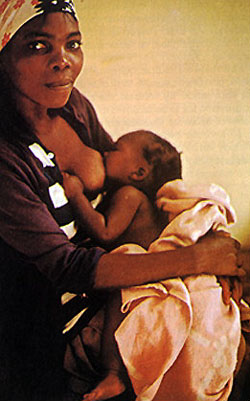The Physical Characteristics of Humans
- Page 24 -
 What this slowing down of development means in practical terms is that human infants are almost completely helpless when they are born and for a considerable time afterwards. It is almost as if they experience another year of gestation outside the womb, while rapid growth of the brain takes place.
What this slowing down of development means in practical terms is that human infants are almost completely helpless when they are born and for a considerable time afterwards. It is almost as if they experience another year of gestation outside the womb, while rapid growth of the brain takes place.
Given the extreme dependency of our offspring, which extends out to 12 or more years of life, the human strategy for successful reproduction necessarily involves having relatively few offspring and devoting enormous amounts of energy to raising each of them. The long intimate relationship of mother and child is probably the central feature of our lives; it forms the basis of much of our later social life. Humans are normally capable of bonding deeply with others and of establishing life-long relationships of many kinds. This capacity seems to be one of the things that distinguish human life. Perhaps this ability to sustain strong emotional bonds with others is related to our long period of juvenile dependency.
Looking at the relationship from the parent side, individual humans and human groups have to be able to provide an unprecedented amount of care and attention to their offspring for the species or cultural group to survive. That means that adults have to have the capacity to knit together into cooperative units. It is interesting to note in this regard that all human societies recognize complex kinship relationships (aunts, uncles, siblings, cousins, etc.) and practice some form of marriage. These relationships may, at bottom, be practical ways of organizing support for the care of children.
An unusual physical characteristic of human females may play a role in this complex set of adaptations: in humans, estrus or the brief fertile period in the female's cycle, is "disguised." That is, neither the woman nor other males is aware of the event. The usual undisguised estrus of mammals can be observed in your dog or cat, if they are have not been neutered. Disguised estrus is unique to humans and our cousins, the bonobos.
In most mammals, such as the larger species of chimps and horses, dogs, cattle, etc., mating behavior is strictly controlled genetically by the hormones released by the female during her fertile period. When a female chimp is in estrus, she mates with the males in the vicinity. The concept of "choice" in these matters cannot be applied to either male or female, who simply respond to hormonal stimuli. To use the example of Pan troglodytes (the larger chimp species), no bonding of chimp males and females occurs in these hormone-driven matings, and no supportive family unit is formed to care for the offspring.
In humans, however, the time that the female is fertile is not perceivable and does not seem to affect sexual behavior. Sexual behavior can occur at any time of the cycle. That is not to say that humans are unaffected by hormonal influences; quite the contrary! But human beings are in a sense freed from the direct control of estrus cycle, and they can choose when or whether to mate. Courtship and mating in humans usually involve elaborate forms of bonding. Frequently, life-long bonds develop between human males and females, although human mating behavior can also be as casual as that of chimps.
It is interesting to speculate how much the development of culture was driven by the need to cooperate to provide care for slow-developing human infants – and how much the long and intense relationship between child and parents influenced the development of language and other aspects of our social behavior.
 What this slowing down of development means in practical terms is that human infants are almost completely helpless when they are born and for a considerable time afterwards. It is almost as if they experience another year of gestation outside the womb, while rapid growth of the brain takes place.
What this slowing down of development means in practical terms is that human infants are almost completely helpless when they are born and for a considerable time afterwards. It is almost as if they experience another year of gestation outside the womb, while rapid growth of the brain takes place. 